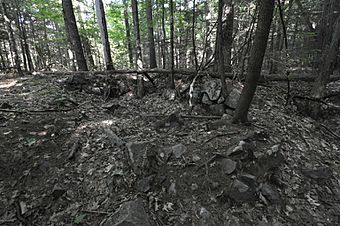Barkhamsted Lighthouse facts for kids
Quick facts for kids |
|
|
Lighthouse Archeological Site (5-37)
|
|

One of the site's cellar holes
|
|
| Location | Peoples State Forest, Barkhamsted, Connecticut |
|---|---|
| Area | 5 acres (2.0 ha) |
| Built | 1740 |
| NRHP reference No. | 91000445 |
| Added to NRHP | April 25, 1991 |
The Barkhamsted Lighthouse was a special historical community in what is now Peoples State Forest in Barkhamsted, Connecticut. It was a small village that existed in the 1700s and 1800s. People from different backgrounds lived there, including Native Americans, African Americans, and white settlers, who often didn't have much money.
The village was located on a flat area above the eastern side of the West Branch Farmington River. It got the name "lighthouse" because its lights were like a signal. They showed travelers on the main road along the river that they were getting close to New Hartford. Today, the old village site is protected and is known as the Lighthouse Archeological Site (5-37). It was added to the National Register of Historic Places in 1991.
Contents
Discovering the Lighthouse Village
This unique village began in the mid-1700s. A man named James Chaugham bought land there. Later, his son Samuel, who was a Narragansett person from Block Island, also lived there. Stories say James Chaugham married Molly Barber, a white woman.
The area was wild and rugged back then, with an old Native American trail running along the river. This trail later became a busy road for stagecoaches. Drivers traveling south would see the lights of the small settlement and call it the "lighthouse." It meant they were almost at New Hartford, a few miles away.
Why the Village Disappeared
The community was eventually left empty in the 1860s. It seems the people who lived there moved away to find better ways to make a living. They were likely looking for more opportunities to earn money and build a stable life.
Uncovering the Past with Archaeology
The first organized history of the Lighthouse community was written in 1952 by Lewis Sprague Mills. He was a local teacher and historian. Later, in 1986, archaeologists began to study the site. Kenneth Feder led these first investigations.
The site is on a flat area on the side of Ragged Mountain, which is a hill in Peoples State Forest. Archaeologists have found the stone foundations of ten buildings. They also discovered four charcoal kilns, which were used to make charcoal. A well and a small cemetery were also found.
The stones used for the building foundations seem to have come from nearby. The buildings were not made with the kind of cut lumber used in most towns. This suggests the villagers used materials they could find easily. Many everyday household items, like pieces of pottery, have also been found.
Visiting the Site Today
You can visit the Lighthouse Archeological Site today! There is a short hiking trail that leads to it from East River Road in Peoples State Forest. The site has been officially named a state archaeological site. This means it's an important place where we can learn about the past.




